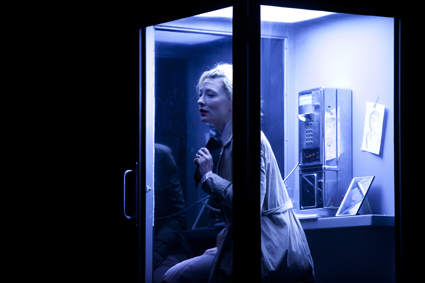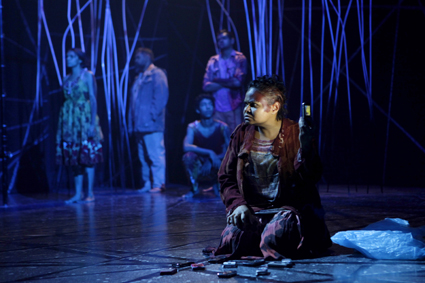outside looking inside out
keith gallasch: bloodland, gross und klein, sydney theatre company

Cate Blanchett, Gross und Klein (Big and Small), Sydney Theatre Company
photo Lisa Tomasetti
Cate Blanchett, Gross und Klein (Big and Small), Sydney Theatre Company
TWO SIGNIFICANT WORKS FROM SYDNEY THEATRE COMPANY, BLOODLAND, A COLLABORATIVE PERFORMANCE CREATED BY AUSTRALIAN INDIGENOUS ARTISTS, AND BOTHO STRAUSS’ 1978 PLAY GROSS UND KLEIN (BIG AND SMALL) CONFIRMED THE COMPANY’S COMMITMENT TO ADVENTUROUS THEATRE-MAKING. BOTH WORKS CAST THE AUDIENCE IN THE ROLE OF OUTSIDER WHILE SIMULTANEOUSLY DEALING WITH THE OUTSIDER’S PLIGHT.
Neither work provides easy access—Bloodland is delivered largely in the Yolgnu tongue of Eastern Arnhem Land (without subtitles) in a discursive often movement-based narrative, while Gross und Klein elliptically tracks the emotional state of a woman whose life is falling apart in increasingly surreal episodes. Yet both works, once entered, reward us with insight into the outsider’s pain.
gross und klein (big and small)
In the opening scene of Gross und Klein, Cate Blanchett delivers the first volley of a tour de force performance, establishing Lotte as the outsider she is, the expansive dimensions of her personality and the potential for the trouble that will come—she is amiably garrulous (we are her confidantes), curious (she listens to two men talking “like total philosophers,” taken by their “throbbing” voices), betrayed (deserted by husband Paul), alone (with a tour group in Morocco who have turned on each other) and visionary (in an outburst about the fate of the Earth that takes her by surprise and anticipates later delirium).
With great vocal and physical ease, Blanchett sustains a remarkable sense of spontaneity and increasing unpredictability so that when Lotte trips into surreal scenarios, dances crazily or argues with God, we can go with her. We accept Lotte’s desire to learn languages, to think, to help, even though we know that the loss of love will repeatedly thwart any ambitions and that, perhaps, we are witnessing a descent into madness—although the world she encounters is possibly madder. Blanchett’s lucid delivery is underpinned by Botho Strauss’ austere writing, fortunately rendered not too idiomatically into English by Martin Crimp who refers to “the blue sky thing,” “nanotechnology” and their like to give the play a more contemporary feel. Crimp retains the play’s sense of foreignness, apt for Lotte’s condition and Strauss’ critique of a disintegrating society where this woman cannot secure a foothold. Blanchett captures perfectly Lotte’s desire to reach out—to an old friend and to perfect strangers (she talks through a window, advising a woman on how to dress; she takes a drunken Turkish man for a walk to sober him up; she visits her brother’s neurotic family; she takes on an office job)—but also to regress (returning to her and Paul’s apartment; attempting hopeless reconciliation; calling their old telephone number from a phone box in the middle of nowhere—an otherwise eerily naked stage).
What makes this production of Gross und Klein particularly disturbing is how painfully funny it is, giving the play’s consistent strangeness a through-line without ever straining to be comic, underlining the sheer happenstance of Lotte’s journey and allowing her to assume the mantle of a divine-ish fool. Having declared of humanity, “we’re not falling, we’re flying apart,” Lotte discards her dress to reveal a glittering showgirl outfit and confronts God: “Don’t come any closer! … I’m not your cup…I can’t take you on as well!” Bleeding and writhing on the floor, she wonders if he (God or Paul?) “wants to make me small.” We know Lotte is bigger than that. And the remaining scenes (a riotously hilarious office job with Blanchett reminding me of the physical bravery of Gena Rowlands in John Cassavettes’ film Love Streams (1984); an encounter with a chess-playing loner at a bus stop that might have become an unlikely relationship; and an apparently purposeless visit to a doctor’s waiting room) all suggest a return to some kind of stability if not normality alongside Lotte’s own asessment: “There’s nothing wrong with me.”
Benedict Andrews (who took over the production from French director Luc Bondy) has directed contemporary German plays here and in Berlin and is the perfect match for Botho Strauss (he has also directed three plays by Martin Crimp for STC). He has elicited consistently strong performances from his cast and worked inventively with Johannes Schultz’s set—a simply framed rectangle within which rooms can unfold or float apart or a strange apartment block glide into view, a highway appear with the laying down of white lines—a world if not “flying apart,” certainly aptly unstable. Gross und Klein is a must see—a great play, equally demanding and rewarding, and an immaculate production with an astonishing central performance that demands we step back and take a look at our lives through a new frame—to see just how sane or not are we and the society that tolerates us.
bloodland

Bloodland, Sydney Theatre Company
photo Danielle Lyone
Bloodland, Sydney Theatre Company
Bloodland posits its non-indigenous audience as outsiders, witness to Indigenous language, ceremony and social tensions largely foreign to us. We have to work hard to find our way into the performance—much of the dialogue is delivered in Yolgnu, the language of the peoples of East Arnhem Land, especially in the early scenes where we’re heavily reliant on non-verbal cues. Later, Aboriginal English and a greater orientation to movement make meaning more transparent. But that initial sense of being an outsider is important, not that it ever leaves us—we are, as usual in the theatre, pretend voyeurs, but here moreso than usual. However, we are not the only outsiders—the clan society we observe has its own.
Cherish (Ursula Yovich), an eccentric loner who collects or most likely steals mobile phones she doesn’t use, mutters ritualistically over her cache the names of their owners. Billy (Kelton Pell) is city-educated, but denied involvement in ceremonies by clan elder Djurrpun (Banula Marika). Nonetheless Billy’s betrothal to young Gapu (Noeline Marika) stands, but it drives the boy who loves her, Runu (Hunter Page Lochard), into tragic isolation. Individual plights are amplified by tension between clans, by arguments between the women—as they make bread—over the obligations of sharing and exacerbated by the gap between learning ceremony and the appeal of hip hop and MP3 players for the teenagers. Added to which is collective despair over control of Indigenous land rights and language by a distant white government. Billy’s making and distribution of the hallucinogenic kava is another complication—its effects realised as a slow-motion tottering as opposed to the vitality and grace of the boys performing a kangaroo dance.
The set for Bloodland amplifies this prevailing sense of darkness and disconnection: a damaged wire fence spans the stage, cage-like, behind which, dimly discerned at first, is nature—evoked abstractly as grasses and spindly trees amidst which members of a clan stand and ominously watch or a dog (David Page) growls ferociously or a clan elder sings while carefully butchering a kangaroo. Near centre-stage, a power pole, sparking dangerously at its peak, leans perilously over land scarred by mining and a people caught between past and present. By the end, we have come to see both the Indigenous individual and their society as outsiders.
Bloodland is a significant if flawed creation, its theatre-cum-dance hybridity feeling at times unresolved, our sense of the key characters too impressionistic, its multiplicity of important issues spread thin in a short work. The crudely satirical scene of a teacher, Miss White, executing her students for declaring themselves Yolgnu ruptured a sense of Bloodland’s tonal consistency. Otherwise, the oscillation between easy-going naturalism and movement based ceremony worked well, although the protracted funeral at the end, for all its sense of ritual and powerful grieving, seemed disproportionate to what had gone before. But, I write as an outsider, witnessing Indigenous Australians made outsiders in their own land, enacting their plight in their own language and powerfully performing it.
Gross und Klein is programmed for the London 2012 Festival; Bloodland is in the programs of the 2012 Adelaide and Perth Festivals. You can see footage of Bloodland at www.sbs.com.au/news/video/2166576735/Bloodland
–
Gross und Klein (Big and Small), writer Botho Strauss, English text by Martin Crimp, director Benedict Andrews, performers Cate Blanchett, Lynette Curran, Anita Hegh, Belinda McClory, Josh McConville, Robert Menzies, Katrina Milosevoic, Yalin Ozucelik, Richard Piper, Richard Pyros, Sophie Ross, Chris Ryan, Christopher Stollery, Martin Vaughan, set designer Johannes Schultz, costumes Alice Babidge, lighting Nick Schlieper, composer, sound designer Max Lyandvert, Sydney Theatre, Nov 19-Dec 23; Sydney Theatre Company & Adelaide Festival: Bloodland, concept, direction Stephen Page, story Kathy Balangayngu Marika, Wayne Blair, writer Wayne Blair, performers Elaine Crombie, Rarriwuy Hick, Rimi Johnson page, Kathy Balangayngu Marika, Noelene Marika, Banula Marika, David Page, Hunter Page Lochard, Kelton Pell, Tessa Rose, Meyne Wyatt, Ursula Yovich, set Peter England, costumes Jennifer Irwin, lighting Damien Cooper, composer Steve Francis; Wharf 1, STC, Oct 7-Nov 13
RealTime issue #106 Dec-Jan 2011 pg. 32






